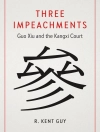Cultural Imprints draws on literary works, artifacts, performing arts, and documents that were created by or about the samurai to examine individual ‘imprints, ‘ traces holding specifically grounded historical meanings that persist through time. The contributors to this interdisciplinary volume assess those imprints for what they can suggest about how thinkers, writers, artists, performers, and samurai themselves viewed warfare and its lingering impact at various points during the ‘samurai age, ‘ the long period from the establishment of the first shogunate in the twelfth century through the fall of the Tokugawa in 1868.
The range of methodologies and materials discussed in Cultural Imprints challenges a uniform notion of warrior activity and sensibilities, breaking down an ahistorical, monolithic image of the samurai that developed late in the samurai age and that persists today. Highlighting the memory of warfare and its centrality in the cultural realm, Cultural Imprints demonstrates the warrior’s far-reaching, enduring, and varied cultural influence across centuries of Japanese history.
Contributors: Monica Bethe, William Fleming, Andrew Goble, Thomas Hare, Luke Roberts, Marimi Tateno, Alison Tokita, Elizabeth Oyler, Katherine Saltzman-Li
Jadual kandungan
Introduction: Remembering the Samurai in Medieval and Early Modern Japan, by Elizabeth A. Oyler and Katherine Saltzman-Li
1. Memento Mori: Mōri Warriors, Manase Physicians, and the New Medico-Cultural Nexus of the Late Sixteenth Century, by Andrew Edmund Goble
2. Hideyoshi and Okuni’s Kabuki: Memories Preserved in a Screen Painting, by Marimi Tateno
3. Finding Origins and Meaning in the Warring States, by Luke S. Roberts
4. Plotting War during the Great Peace: The Uses of Warfare in Late Edo Tales of the Strange, by William D. Fleming
5. Ghosts along the Road: War Memory and Landscape in Medieval Narratives, by Elizabeth A. Oyler
6. Narrated and Danced Memory of Warand Resignation: The Role of Musical Delivery, by Alison Tokita
7. Performing Trauma and Lament: Gendered Scenes of Samurai Anguish on the Eighteenth-Century Kabuki Stage, by Katherine Saltzman-Li
8. In Memorandum: Dragonflies and Drums, by Monica Bethe
9. Representing Memory in the Warrior Plays, by Thomas Hare
Mengenai Pengarang
Elizabeth Oyler is Associate Professor of Japanese at the University of Pittsburgh. She is the author of Swords, Oaths, and Prophetic Visions.Katherine Saltzman-Li is Associate Professor of Japanese Literature and Theatre at the University of California, Santa Barbara. She is the author of Creating Kabuki Plays.












